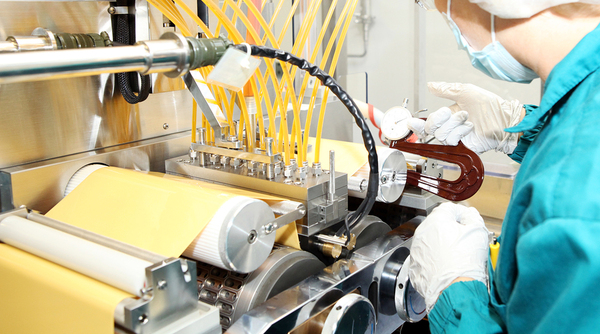
Food manufacturers need modern approaches to production, customers, and markets. In a hypercompetitive industry, technology can help companies gain valuable insights, improve operational efficiency and gain market share.
In The food manufacturer’s strategic guide to technology, we take a closer look at the tools that can transform food production and why they are so effective. Specifically, we’ll look at three types of software:
- Business Intelligence (BI)
- Customer Relationship Management (CRM)
- Enterprise Resource Planning (ERP)
ERP is the binding force that connects BI and CRM systems with other internal systems to provide leaders with high-level integrated data. Together, these three software platforms can help food manufacturers work at peak levels of efficiency.
While there may be overlap among these types of software depending on the product and its features, there are some basic functions each typically provides.
BI software allows companies to improve operational efficiency and supply chain performance. BI tools give companies:
- Improved product planning and management
- Visibility into product demand and operational performance
- Improved management of customer accounts
BI systems aggregate data on markets, customers, and production to generate powerful insights. By collecting data into useful dashboards, charts, and reports, BI can demonstrate opportunities or inefficiencies that require changes to business strategy, policy or process.
Depending on the software platform’s features, BI may provide the following:
- Detailed information on product consumption
- Analysis of accounts and sales
- Deeper understanding of category performance and market share
- Align demand and supply
- Optimize inventory
- Monitor the supply chain
- Analysis of trade promotions
- Pinpoint opportunities for expansion by analyzing cross-sell and up-sell approaches, channel analysis, market analysis and geographic sector analysis
- Assess the manufacturing efficiency
- Calculate real profitability of products
With a focus on Key Performance Indicators (KPIs) and other reports, BI gives executives, sales managers, production managers, and financial leaders a better indication of overall performance. Decision-making can be done faster and more be more accurate.
With the right BI solution, companies can use those KPIs and reports to optimize sales strategies, plan better for sales, automate budget planning and projections and provide a deeper connection between planning and operations.
Customer relationship management solutions
CRM tools capture critical information about customers and potential customers. Your CRM contains names, titles, contact information and decision-making data of key contacts within a customer or prospect company.
These systems also can capture information gained during interactions with a customer, including meeting notes, responses to calls, emails or visits, and reactions to marketing materials, such as which emails are opened or downloads accessed.
CRM systems help sales executives create sales projections manage contacts with customers, verify shipping addresses, and create invoices. At its core, the CRM is the hub of customer data that can drive more sales, improve customer retention and allow for better customer relations.
Advanced CRM features use automation to help sales forces and marketing teams manage their time more efficiently. Automation helps track when follow-ups some be made and allow for segments and personalized communication with potential clients.
From a customer service perspective, a CRM allows for customer service reps to understand the full nature of the customer relationship in providing assistance. With a complete picture of the client, resolution times are shorter and customer satisfaction improves.
Tying it all together with enterprise resource planning solutions
Businesses that want to maximize actionable data from multiple sources turn to ERP solutions. ERP allows for sharing of information collected from multiple systems.
ERP systems integrate business intelligence and customer relationship data with information from other parts of the company. Finance, marketing, operations, inventory and shipping data, and systems information are melded together, giving workers, executives and supply chain partners comprehensive, holistic information.
What are some of the key advantages of bringing together ERP, BI and CRM systems? Here are a few:
- Better Inventory Control. An ERP lets you better balance stock levels and warehouse inventory. Optimized inventory levels allow companies to reduce overstocking and to prevent tying up working capital.
- Improved Waste Management. Limited shelf life means waste is a major issue for food and beverage manufacturers. With an ERP system, you can create faster distribution processes that result in improved quality and less wasted ingredient and product.
- Strategic Demand Management. With better intelligence, a clearer understanding of customer needs, and a deeper sense of consumer trends, companies can shift business strategies and adjust products quickly.
- Reduced Labor and Operational Costs. Automation features in these systems allow for the elimination of redundancies, which can cut labor costs, allowing staff to focus on more productive and profitable work. Aggregating production and financial data helps to identify efficiencies that can be gained by reworking business processes.
- Responsive Customer Relations. With integrated systems, customers can receive quotes immediately. Open cases can be tracked in real time. Customers can engage with your company across multiple channels, including social and the web, and on mobile devices.

The Role of ERP and Compliance
Compliance is a major consideration for food and beverage companies today. The rollout of the federal Food Safety Modernization Act (FSMA) places additional burdens on companies to ensure that products and ingredients are tracked throughout the supply chain.
These regulations give the U.S. Food and Drug Administration (FDA) additional powers over company inspections and product recalls. In short, the FSMA requires companies to:
- Have food safety plans in place
- Ensure FSMA compliance for suppliers
- Use sanitary practices in the transportation of food
- Verify that foreign imports are produced using safety standards
By mid-2019, companies need to have risk reduction plans in place. These plans must include a vulnerability assessment and a detailed mitigation strategy that includes verification systems, corrective actions, monitoring and thorough recordkeeping.
The food safety plan is also known as a Corrective and Preventative Action (CAPA) plan. It’s a continuously evolving series of documents that are used to identify and eliminate problem issues with food safety.
The CAPA helps determine the root cause of a deviation in food safety and detailed steps to be taken to avoid a recurrence of the issue. Corrective action plans may be prompted by several incidents, including customer complaints, issues identified during food safety audits or regulatory inspections.
Preventative actions are developed in response to an assessment of potential threats to food safety and detail steps to combat those issues. Under FSMA, the written preventative controls must include:
- An evaluation of hazards that could affect food safety
- Details about which steps will be put in place to minimize or prevent those hazards
- Specifics about how the facility will monitor the controls
- Recordkeeping
- Actions a facility will take if an issue arises
With an ERP allows for facility-wide documentation of CAPA and other documentation required by FSMA. In the event of a food safety issue, the ERP allows for real-time access to information that can accelerate response times. Track and trace functions allow for rapid response during a recall, with detailed information about raw ingredients, supply chain compliance, food labeling, transportation and distribution and final destinations.
How to select the right ERP
There are a wide variety of ERP providers. To make the right decision, food manufacturers should consider companies with specialized products designed specifically for the industry. Many ERP companies serve broad markets and are not designed to serve food and beverage makers.
When it comes to selecting the right ERP, companies need to plan carefully and commit to the investment in budget and resources to ensure the proper transition.
NexTec is a leader when it comes to helping companies select the proper ERP. Our nationwide team of consultants has vast product knowledge of the companies, their products, and the features that make ERPs.
NexTec partners with Sage X3 to deliver powerful solutions for our customers. The Sage X3 ERP for food and beverage manufacturers integrates operations, supply chain, warehouse and inventory, finance and accounting, sales and marketing, and customer service functions.
Sage X3 includes features designed specifically for the food and beverage industry, including:
- Traceability tools that handle expiration management, allergen-free production, sustainability, and labeling. Forward and backward traceability functions across the supply chain; ingredient tracking by supplier, plant, batch, lot or sub-lot.
- Recall management that allows for situations to be managed in minutes, not hours or days.
- Supply and demand forecasting intelligence in an easy-to-use, customizable interface.
- Formula and recipe management.
- Quality management to track and maintain testing of raw materials, intermediate products, and finished goods.
- Workload management tools to assess purchase orders, batch scheduling, and batch production.
- Warehouse management to reduce write-offs, including shelf-life management tools, RF support, barcode printing and directed put-away and pick planning functions.
- Production management to plan production runs by user-defined criteria, rescale to respond to constraints, work-order updating, and consistent batch composition for repeat orders.
- Financial management of general ledger, budgeting, expense and fixed-asset management and accounting.
- Catch weight management, weighing scales, product packaging and production cost accounting.
- Sales management, including pricing and discounts, quotes, contracts, order prep, delivery, invoicing, reminders, sales commissions and customer returns.
- Customer service, including contact management, sales force automation, marketing and customer support.
NexTec has developed more than two dozen proprietary add-ons to enhance the functionality of the Sage X3 product. These add-ons include:
- Product recall management that streamlines identification, notification, reporting and tracking functions.
- RFID tagging that improves production and reduces warehouse management costs.
- Catch weights that accurately price products based on actual per-case weight.
- Consumer issue management to track and resolve issues with direct customers and end customers.
- Automated CAPA functions that are FDA-compliant in managing risk.
- An allocation module that uses product availability data to identify the closest available warehouse to ship from, reducing shipping costs and raising efficiency and customer satisfaction.
- Electronic data interchange (EDI) functionality via FTP, AS2, Value Added Network (VAN) and other data exchange methods to improve integration with suppliers and customers.
- Expiration date management to certify sales tax exemptions, subcontractor credentials and U.S. Department of Agriculture certifications.
- Point-of-sale solutions for counter sales, mobile sales or complete POS integration.
ERP, BI, and CRM tools can have a transformational impact on the efficacy and efficiency of food and beverage companies. With strategic partners Sage X3 with add-ons from NexTec, companies can gain market share and ensure compliance. To learn more about NexTec can help your company, download the NexTec Food Brochure.

